Investigation of FOXP3 (rs3761548) polymorphism with the risk of preeclampsia and recurrent spontaneous abortion: A systemic review and meta-analysis
Govinda Sri Varshini, Sivakumar Harshini, Muhammed Ali Siham, Govindaraj Krishnamurthy Tejaswini, Yasam Santhosh Kumar, Langeswaran Kulanthaivel, Gowtham Kumar Subbaraj
1Faculty of Allied Health Sciences, Chettinad Hospital and Research Institute, Chettinad Academy of Research and Education (Deemed to be University), Kelambakkam,Tamil Nadu 603 103, India
2Department of Bioinformatics, Alagappa University, Karaikudi-630 003, Tamil Nadu, India
ABSTRACT
Objective: To investigate the association between forkhead box P3(FOXP3) (rs3761548) polymorphism and the risk of preeclampsia and recurrent spontaneous abortion.
Methods: Literature on the association of FOXP3 gene polymorphisms and susceptibility to preeclampsia and unexplained recurrent spontaneous abortion was retrieved by searching databases such as PubMed, Science Direct, Google Scholar and Embase from 2000 to 2021. The association measure was analyzed using an odds ratio (OR) and 95% confidence interval (CI). All the statistical analyses were executed using RevMan 5.4 software.
Results: In the present meta-analysis, 11 articles were analyzed.The pooled results showed no association between FOXP3 gene polymorphism (rs3761548) and preeclampsia risk in allelic,recessive, dominant and over dominant contrast models. FOXP3 gene polymorphism (rs3761548) showed an association with recurrent abortion in allelic, recessive and dominant models (OR 1.85, CI 1.59-2.14; OR 2.02, 95% CI 1.56-2.62; OR 2.69, 95% CI 1.50-4.83, respectively), while no association in the over dominant contrast model (OR 1.35, CI 0.87-2.10).
Conclusions: In the present study, FOXP3 gene (rs3761548)polymorphism is associated with risk of recurrent spontaneous abortion but not preeclampsia. However, larger sample size and multiracial studies are needed in the future to confirm the findings.
KEYWORDS: Preeclampsia; FOXP3 gene; Single nucleotide polymorphism; rs3761548; Unexplained recurrent spontaneous abortion
1. Introduction
Preeclampsia is a severe pregnancy complication in which normal women have elevated blood pressure after 5 months of pregnancy[1].Preeclampsia is a hypertensive pregnancy condition that causes death and morbidity in both mother and fetus. It affects 5% of all pregnancies in every population; 2%-8% of all pregnancies worldwide (2 to 8 in 100)[2]. It is linked to placental perfusion problems, proteinuria, edema, and multiple organ failure. Its clinical manifestations range from mild hypertension to severe hypertension[3]. Preeclampsia causes cephalgia, unclear vision, light sensitivity, exhaustion, emesis, upper right abdominal pain, dyspnea,and contusions. Normal pregnancy generates unique conditions for the mother's immune system, allowing infection tolerance. Because the fetus expresses paternal antigens, a pregnant woman's immune regulatory competence is critical for a good pregnancy[4]. Although the reasons for this problem are unknown, the pathophysiology has an immunological basis. According to some of the recent researches, a loss of cytokine-mediated endothelium due to elevated maternal inflammation during the gestational period has a significant part in the pathophysiology of preeclampsia. The risk of pregnancy complications rises as the population of regulatory T (Treg) cells decreases. T helper-0 (CD4+) cells give rise to T cells, but Treg cells suppress the immune system. Forkhead box P3 (FOXP3) variations show the progress of preeclampsia through quantitative or functional impacts on Treg CD4+CD25+[5].
Recurrent spontaneous abortion or unexplained recurrent abortion is a condition where two or more pregnancy miscarriages occur after 20 weeks of gestation[6]. Complex etiological factors like chromosomal (2%-5%), anatomic (15%), endocrine, autoimmune(20%), reproductive tract infections (1%-2%), and hormonal(20%) have been documented as causes of recurrent spontaneous abortion[7]. Women experiencing pregnancy difficulties, such as repeated pregnancy loss and hypertension, have been found to have lower amounts of circulating Treg. The lack of immune tolerance at the decidua is one of the reasons for unexplained recurrent spontaneous abortion. An association between the FOXP3 gene polymorphism and preeclampsia, recurrent spontaneous abortion risk was previously reported in multiple case-control studies.
Therefore, to investigate these genetic associations, systematic review and meta-analysis are required. The present systematic review and meta-analysis were designed to determine the association between the FOXP3 gene polymorphism and the risk of diseases such as preeclampsia and recurrent spontaneous abortion.
2. Materials and methods
This systematic review and meta-analysis was reported as per Preferred Reporting Items for Systematic Review and Meta Analysis (PRISMA) guidelines. The review protocol was registered prospectively with PROSPERO (Id No 32617).
2.1. Literature search
In this study, all the articles were retrieved from various databases such as PubMed, Science Direct, Google Scholar and Embase from 2000-2021. The English language was used for the search strategy.Keywords used to retrieve the articles were "FOXP3", "rs3761548","single nucleotide polymorphism", "preeclampsia", "recurrent abortion”, "gene polymorphism", and “hypertension". An advanced search was conducted using the wildcard symbol '*' in combination with Boolean operators ('AND', 'OR', 'NOT') to narrow down the search scope. Additional references were manually searched from the lists of references in all related reviews and articles.
2.2. Inclusion and exclusion criteria
We selected the studies based on the following exclusion criteria: i)case-control studies; ii) studies which evaluated the association of the FOXP3 (rs3761548) gene polymorphism and risk of preeclampsia and recurrent abortion with allelic frequency and genotyping with a 95% confidence level were included. Only English-language articles were considered.
Exclusion criteria were: i) studies that contained only control groups; ii) studies that were reported on animal studies; iii) review articles; iv) studies that did not contain genotypic data.
2.3. Data extraction
In the present meta-analysis, three authors (Govinda Sri Varshini,Sivakumar Harshini, Muhammed Ali Siham) extracted the data from various articles that contained the year of publication, journal and author's name, methodology, study type, allelic frequency,genotyping of 95% confidential interval (CI) with odds ratio (OR),and the P-value of Hardy Weinberg equilibrium. The Newcastle-Ottawa tool was used to assess the risk of bias in observational studies. Studies were classified as high-quality (≥7 stars), mediumquality (4-6 stars) or low quality (0-3 stars). The data were extracted into a table and were analyzed to improve screening adaptability.
2.4. Heterogeneity, sensitive analysis and publication bias
In order to assess the possibility of heterogeneity, the Mantel-Haenszel model was used. Heterogeneity was done by forest plot.For estimating publication bias, we used Egger's linear regression test and visual funnel plots. There can be a publication bias if there was an asymmetric plot; t-test can be used for verification.Sensitivity analysis was not performed due to less number of studies.
2.5. Statistical analysis
In the present meta-analysis, 95% CI with OR was assessed to find the association of FOXP3 gene polymorphism with the risk of preeclampsia and recurrent abortion. The statistical considerable value of P was less than 0.05. A P value of less than 0.1 indicated the presence of heterogeneity (I2) and I2value of 25%, 50% and 75% represented low, moderate and high heterogeneity, respectively.When I2is less than 50%, fixed effects model was used, and random effects model was used when I2is between 50% to 90% as it represents substantial heterogeneity between the studies. For the Hardy Weinberg equilibrium examinations, a Chi-square test was executed. Hardy Weinberg equilibrium for random and fixed effetcs models was carried out. The meta-analysis was conducted using the software Review Manager 5.4.
3. Results
3.1. Search results
The preliminary searches in Science Direct, PubMed, Google Scholar, and Embase resulted in the retrieval of 100 articles relevant to the present study. Fifty articles were removed due to replicative and duplicative contents. Articles that were irrelevant to topics and not of human subjects were excluded. After excluding studies with overlapping data, irrelevant data, and other languages, 25 articles were screened, with 11 being eligible for the qualitative analysis.The search strategy of FOXP3 gene polymorphism is shown in Figure 1.
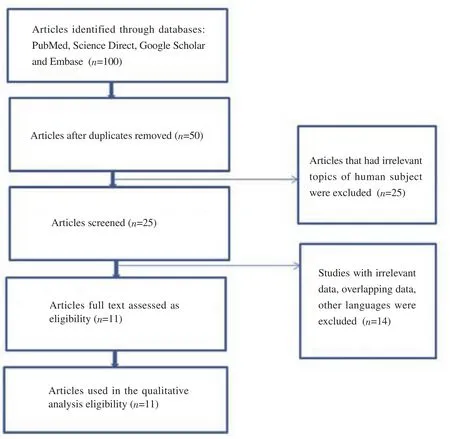
Figure 1. Flow chart of the literature search and selection of FOXP3 gene polymorphism.
Eventually, in the present meta-analysis, the literature showed a total of 5 studies for the association of FOXP3 gene with preeclampsia consisting of 1 370 cases and 1 257 controls, and 6 studies for recurrent abortion consisting of 736 cases and 802 controls.
Table 1 illustrates the characterstics features such as ethnicity,genotype (cases/conrols) of the present investigation. The gene polymorphism of FOXP3 and preeclampsia risk showed four Asian studies[8-10,5] and one Caucasian study[11]. The FOXP3 gene polymorphism with risk of recurrent abortion showed five Asian studies[12-16] and one Caucasian study[17].

Table 1. Characteristics of the studies for the association of FOXP3 polymorphisms with preeclampsia and recurrent abortion risk.
3.2. Quantitative data analysis
A total of five studies were included in this meta-analysis in order to evaluate FOXP3 gene polymorphism and its association with preeclampsia risk. According to the pooled results, the FOXP3 polymorphism was not associated with preeclampsia risk in allelic(OR 0.78, CI 0.54-1.13), recessive (OR 0.64, CI 0.35-1.15), dominant(OR 0.77, CI 0.51-1.16), and over dominant contrast models (OR 1.17,CI 0.99-1.37). The subgroup analysis for heterogeneity was also assessed and the results showed no association in allelic, recessive,dominant and over dominant contrast models (Figure 2, 3).
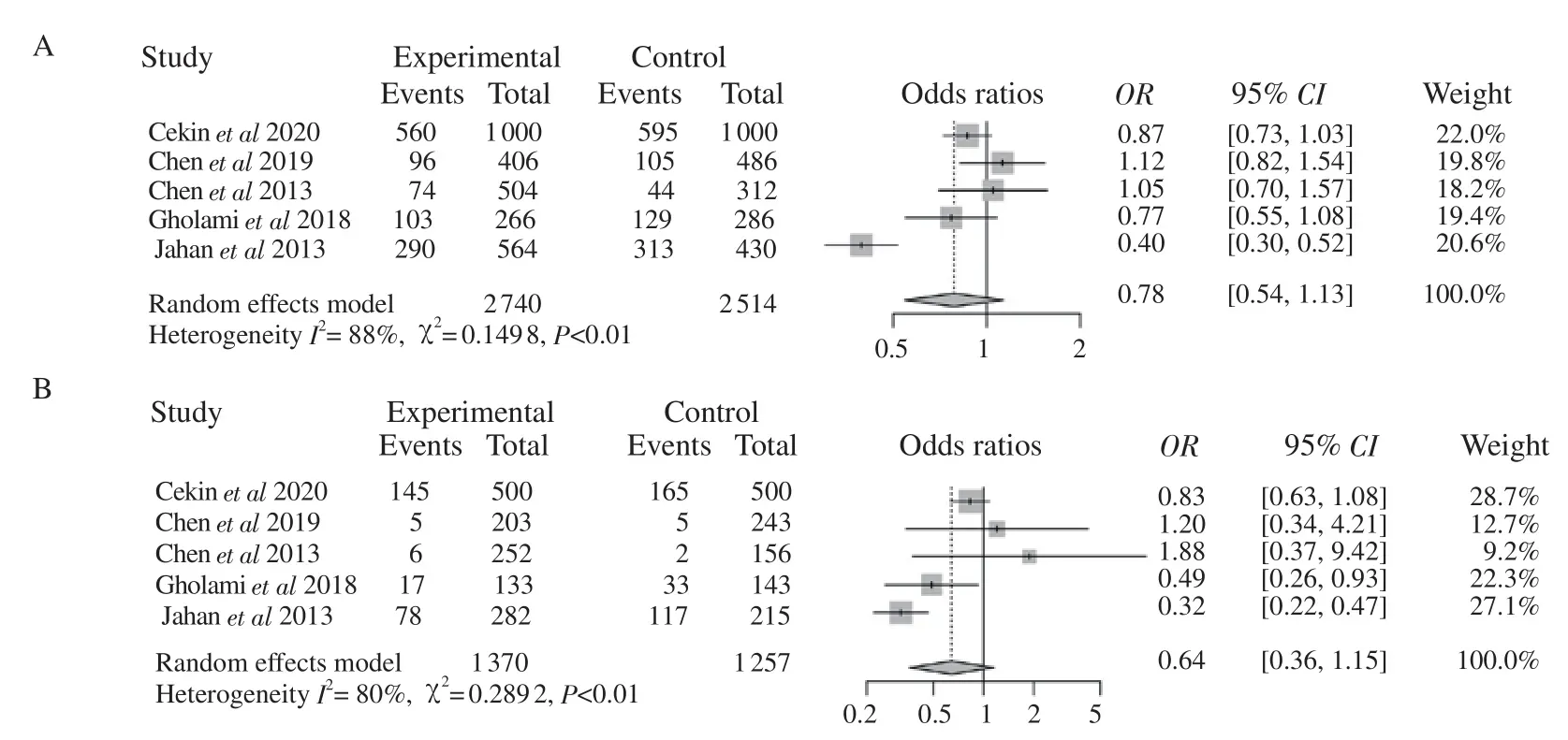
Figure 2. Forest plots for the association of FOXP3 gene polymorphism with preeclampsia risk under allelic (A), recessive variants (B).
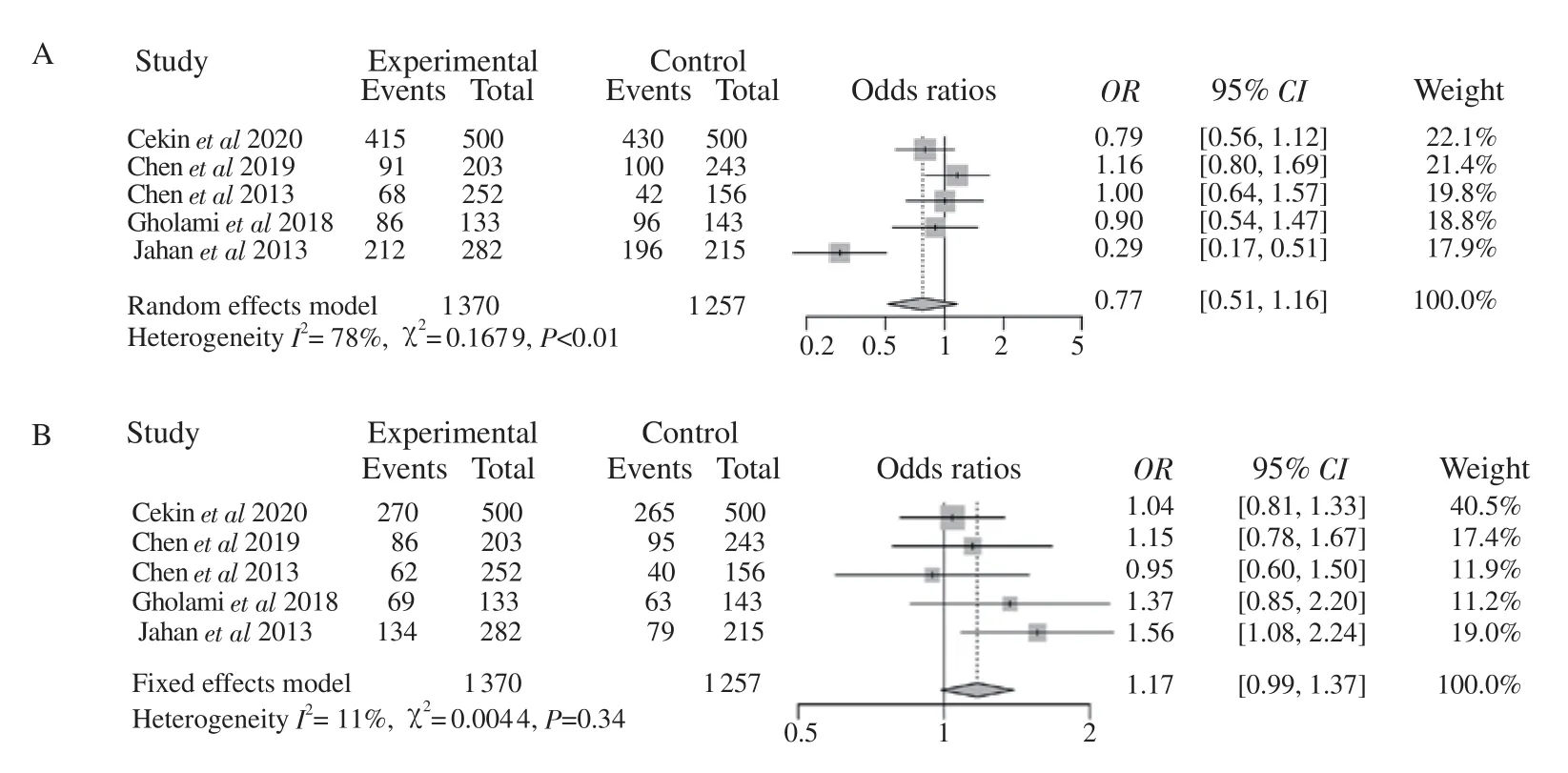
Figure 3. Forest plots for the association of FOXP3 gene polymorphism with preeclampsia risk under dominant (A) and over dominant variants (B).
A total of 6 studies were examined for the association of the FOXP3 gene polymorphism and recurrent spontaneous abortion risk. The pooled results revealed that the FOXP3 polymorphism was associated with recurrent abortion risk in allelic (OR 1.85,CI 1.59-2.14), recessive (OR 2.02, CI 1.56-2.62) and dominant models (OR 2.69, CI 1.50-4.83), while no association in the over dominant contrast model (OR 1.35, CI 0.87-2.10). The subgroup analysis for heterogeneity was also assessed and the results showed an association in dominant, allelic and recessive models, while no association in the over dominant contrast model (Figure 4, 5).
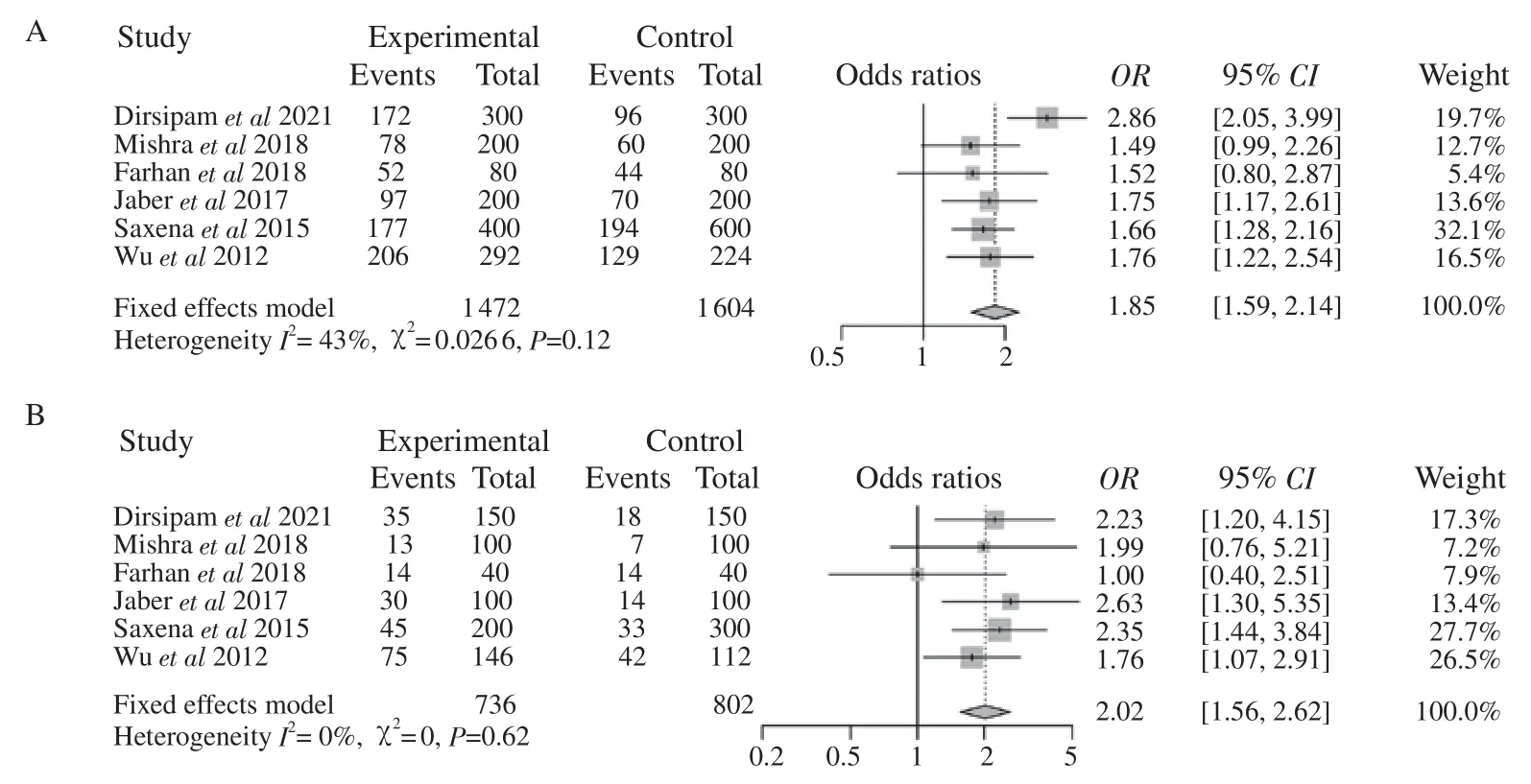
Figure 4. Forest plots for the association of FOXP3 gene polymorphism with recurrent abortion risk under allelic (A), recessive variants (B).
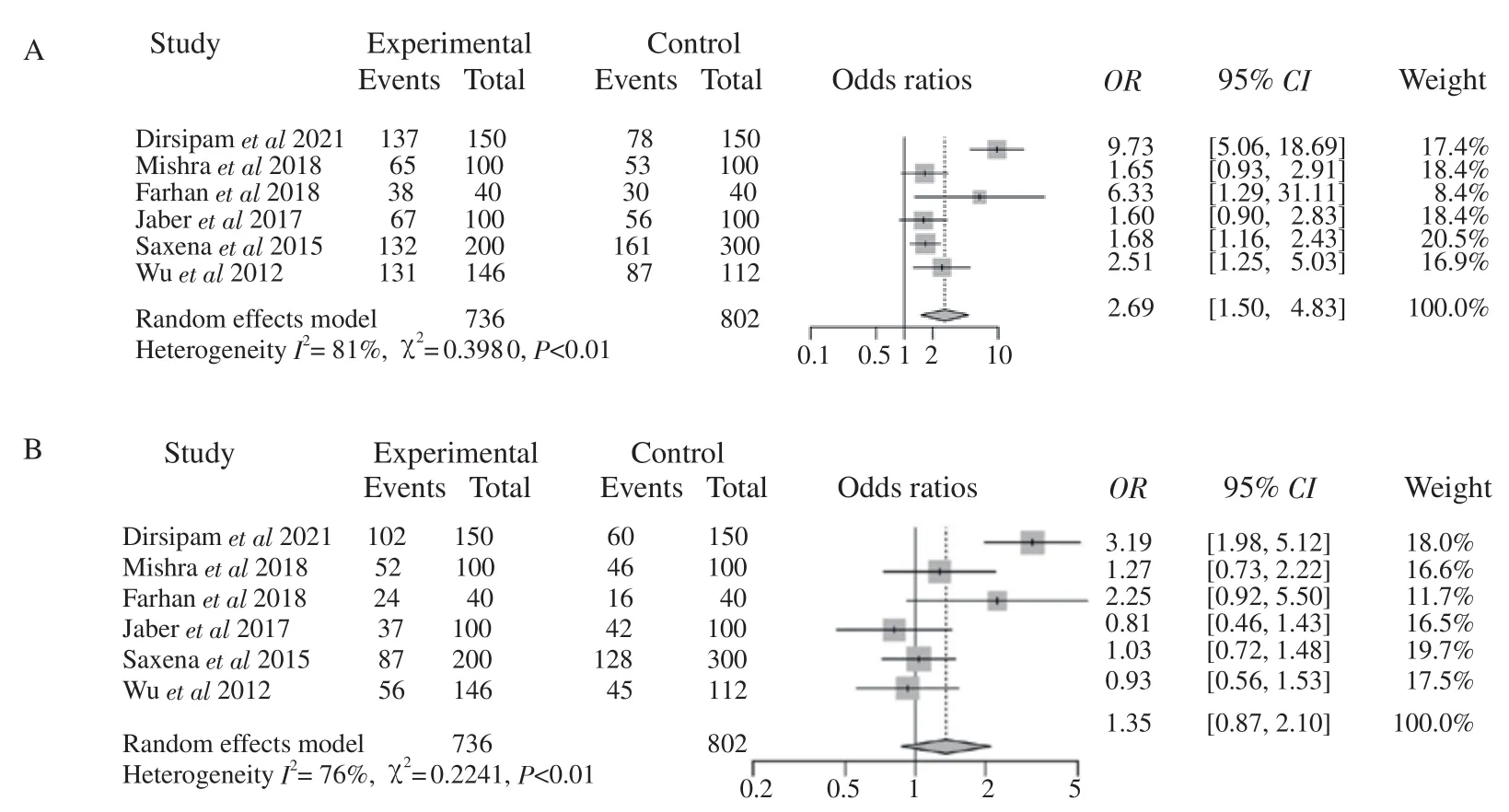
Figure 5. Forest plots for the association of FOXP3 gene polymorphism with recurrent abortion risk under dominant (A) and over dominant models (B).
3.3. Heterogeneity, sensitive analysis and publication bias
Sensitivity analysis for individual studies was not done due to small number of studies. Heterogeneity was done by forest plot and publication bias was analyzed using funnel plot. The funnel plot displayed the y-axis as sample size and the x-axis as effect size. All the results were constant, suggesting that the present study results were statistically stable (Figure 6, 7).
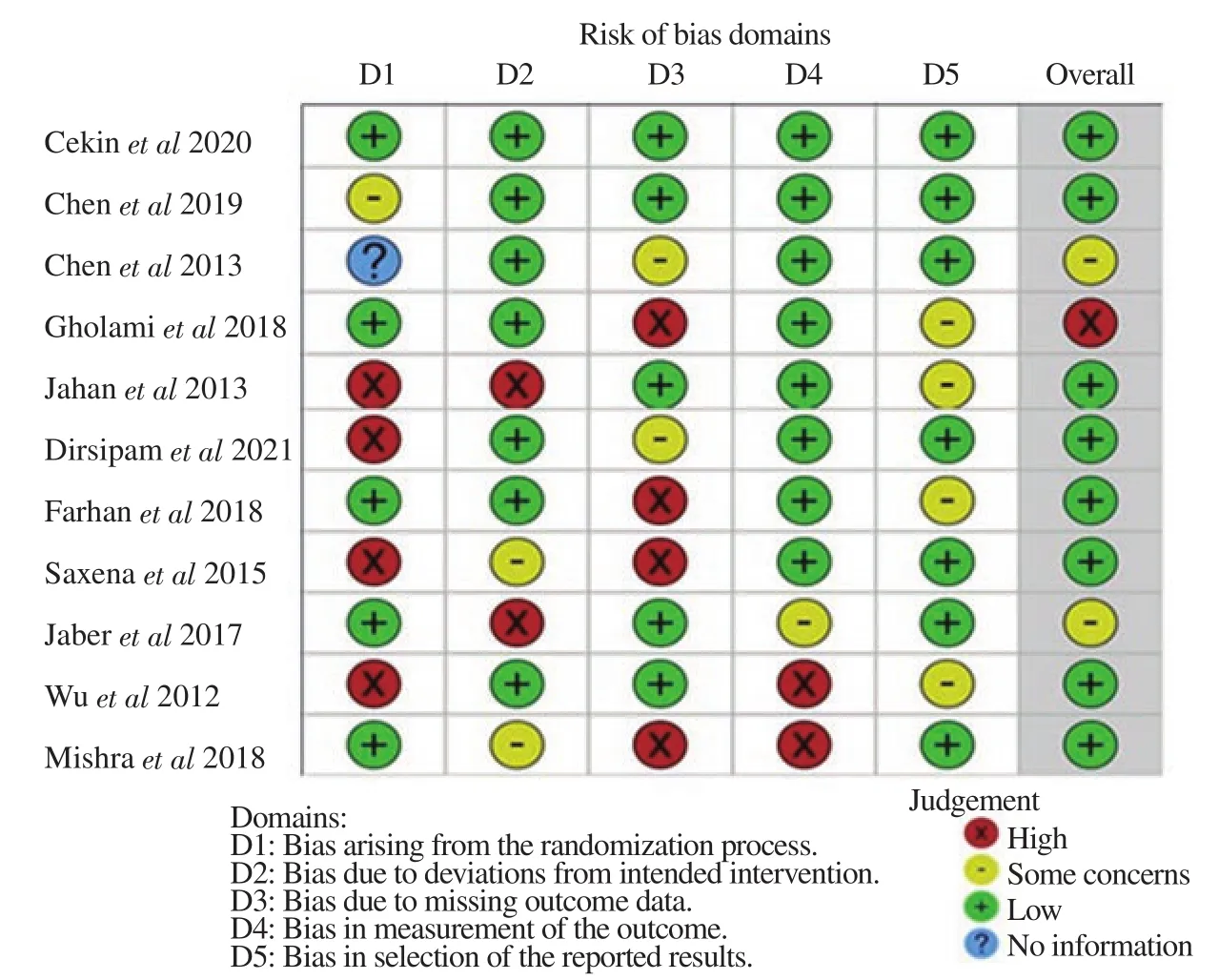
Figure 6. Risk of bias summary.
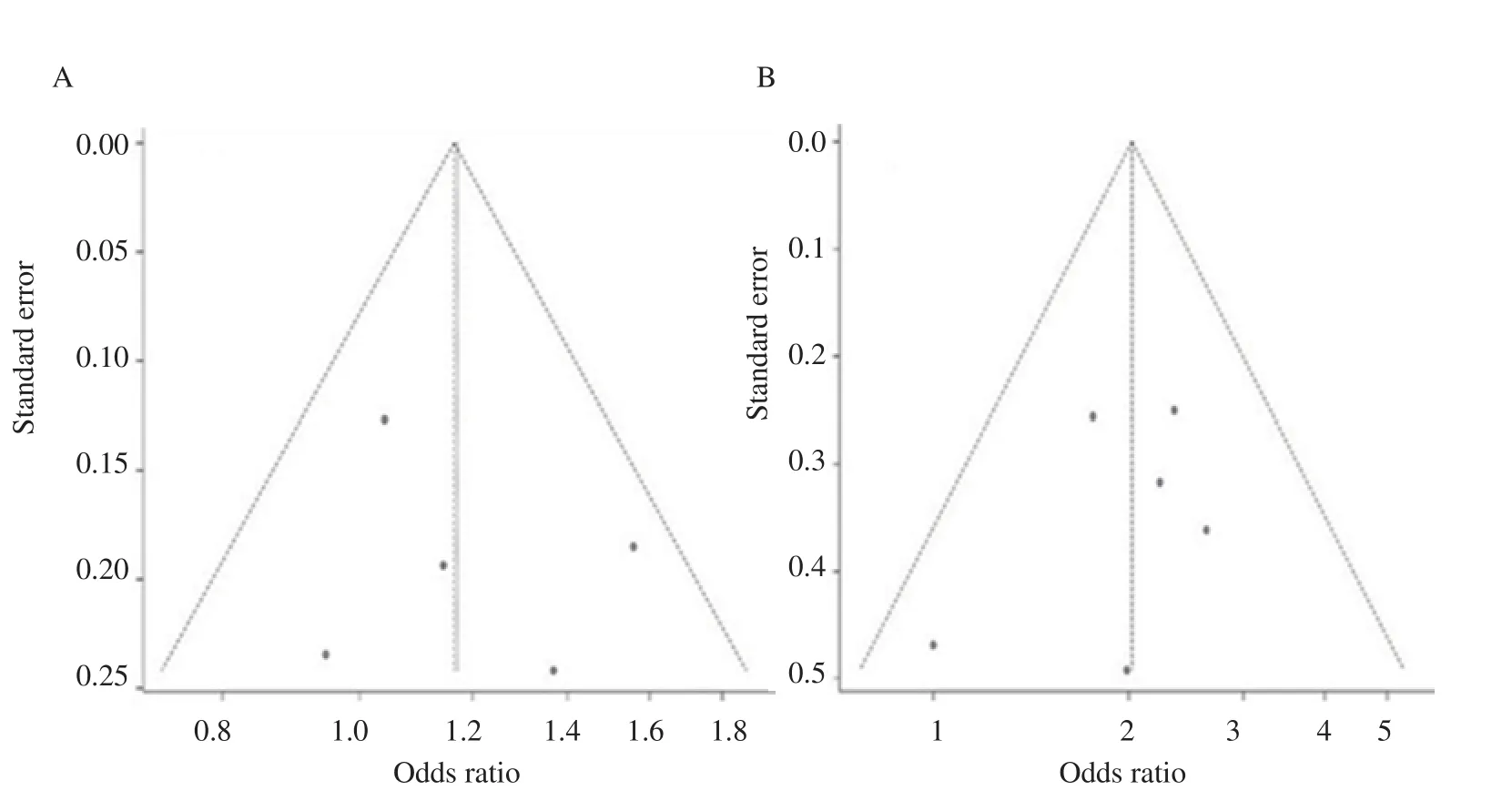
Figure 7. Publication bias analyzed by the funnel plot association of FOXP3 gene polymorphism with various diseased conditions: A) Preeclampsia; B)Recurrent abortion.
4. Discussion
Meta-analysis is a formal, epidemiological, quantitative design that methodically assesses the outcomes of previous studies to determine the conclusions about that body of research[18]. The current meta-analysis includes a total of 2 106 cases and 2 059 controls gathered from different databases. Xp11.23 encodes FOXP3 protein, a member of the forkhead/winged-helix transcription factor family. It functions as a transcriptional regulator in the lowcytokine production of Tregs[10]. There are four potential functional domains: an N-terminal repressor, a zinc finger, a leucine zipper, and a C-terminal fork. At the N-terminus of FOXP3, a repressor domain is present, which inhibits the nuclear factor of activated T-cells mediated transcription process. The FKH domain is required for both DNA binding and nuclear localization. The fork-head domain is the most frequently attacked in patients with immune dysregulation,polyendocrinopathy, enteropathy, X-linked syndrome. The FOXP3 protein is transcribed by regulatory T cells[12].
FOXP3 is also assiciated with allergic rhinitis, endometrial cancer, parasitic and viral infection, HIV, autoimmune diseases,transplantation tolerance. Chen et al[19] reported the FOXP3 gene polymorphism association with cancer risk in the Chinese population and the results of pooled data showed an increased risk of cancer in the AA genotype particularly in the A allele. Zhang et al[20] reported the FOXP3 gene polymorphism with multiple sclerosis risk and the results revealed that dominant and allelic variants showed a strong association while recessive and over dominant variants were associated with multiple sclerosis susceptibility. Li et al[21] reported the FOXP3 gene polymorphism and risk of Graves’ disease and the results revealed that the FOXP3 gene polymorphism was associated with the risk of Graves' disease among the Asian population,while FOXP3 gene polymorphism in Caucasia people cannot be determined due to less number of studies. Pan et al[22] reported the case-control study of FOXP3 rs2232365 gene polymorphism with the risk of preeclampsia and the results of pooled data showed an increased risk of preeclampsia in CC genotype particularly in C. Zhang et al[23] reported FOXP3 gene polymorphism with the risk of allergic rhinitis and the results revealed that FOXP3 gene polymorphism was not associated with the risk of allergic rhinitis.He et al[24] reported the association of FOXP3 gene polymorphism with the risk of autoimmune disorders and the results showed autoimmune disorders risk in the AA genotype particularly in the A allele.
Karimian et al[25] reported the meta-analysis of FOXP3 rs3761548 gene polymorphism with the risk of preeclampsia. The results revealed that FOXP3 rs3761548 gene polymophism may be a protective risk factor against preeclampsia. Hosseini Teshnizi et al[26] reported the meta-analysis of FOXP3 rs3761548 gene polymorphism with the outcome of pregnancy. The results showed that FOXP3 rs3761548 gene polymorphism was associated with the immune related pregnancy complication. In the present investigation,we perfomed meta-analysis to reveal the association of FOXP3 gene polymorphism with the risk of recurrent spontaneous abortion. The results of preeclampsia showed no association in allelic, recessive,dominant and over dominant contrast models. The results of recurrent spontaneous abortion showed an association in dominant,allelic and recessive models, while no association was observed in over dominant contrast model.
In the present study, all the outcomes of FOXP3 gene polymorphism were fit for Hardy Weinberg equilibrium. We analyzed the publication bias for FOXP3 gene polymorphism and all the results were statistically significant and stable.
There are some limitations in the study. The results regarding association of FOXP3 gene polymorphism with the risk of diseases such as preeclampsia and recurrent spontaneous abortion were based on combining unadjusted findings of eligible studies due to the lack of raw data. The FOXP3 gene polymorphism may also be affected by environmental factors. Unfortunately, we did not perform comparison between different ethnicities (Asian and Caucasian) due to the limited number of studies.
In conclusion, our meta-analysis shows that FOXP3 gene(rs3761548) polymorphism is associated with risk of recurrent spontaneous abortion but not preeclampsia. The forest plot is plotted using the random and fixed effects models; publication bias is analyzed using funnel plot. This article discusses preeclampsia,a polygenic disease that can be influenced by a variety of factors,with FOXP3 being an important factor that should not be ignored.The study further explains the relationship between the functional polymorphism rs3761548 A/C and recurrent spontaneous abortion.However, more extensive investigations are needed in future to explore the FOXP3 gene polymorphism with other ethnic groups.
Conflict of interest statement
The authors declare that there is no conflict of interest.
Funding
The study received no extramural funding.
Authors’ contributions
Govinda Sri Varshini, Sivakumar Harshini, Muhammed Ali Siham,Govindaraj Krishnamurthy Tejaswini and Yasam Santhosh Kumar performed data analysis and wrote the manuscript. Langeswaran Kulanthaivel involved in the data validation and revison. Gowtham Kumar Subbaraj designed the study and approved the final version of the manuscript.
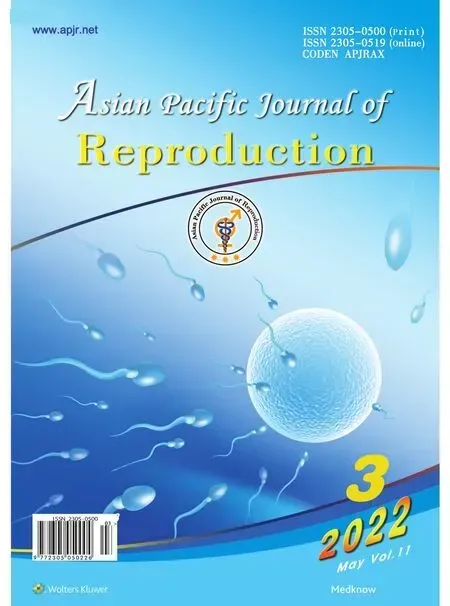 Asian Pacific Journal of Reproduction2022年3期
Asian Pacific Journal of Reproduction2022年3期
- Asian Pacific Journal of Reproduction的其它文章
- Oxidative stress and female reproductive disorder: A review
- Sperm DNA fragmentation does not affect the clinical outcomes in the cumulative transfers of an ICSI cycle along with blastocyst transfers in couples with normozoospermic male patients
- Placental pathologies and fetal outcome in pregnant women with COVID-19: A retrospective study
- Antioxidant potential of pentoxifylline on spermatozoa of small ruminants
- Effect of cholesterol-loaded cyclodextrin enriched extenders on the quality of prefrozen and frozen buffalo semen
